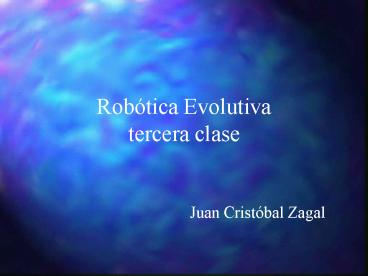Robtica Evolutiva tercera clase PowerPoint PPT Presentation
1 / 23
Title: Robtica Evolutiva tercera clase
1
Robótica Evolutivatercera clase
- Juan Cristóbal Zagal
2
Evolution of Simple Navigation
- Robot is put into an environment with some
obstacles - Objective cover the longest possible distance
without colliding with objects - Braitenberg vehicle weighted connections between
- sensors readings and motor commands similar
to a neural network
3
Braitenberg Vehicle
- Excitatory connections (wgt0)
- rotation speed is proportional to the
activation of the sensor - Inhibitory connections (wlt0)
- rotation speed is inverse proportional to the
activation of the sensor
vleft w10w11 s1 w1n sn vright w20w21 s1
w2n sn
4
Fitness Function
- Objective maximize forward motion while avoiding
obstacles - Fitness V (1-?v1/2) (1-i)
- V vleftvright / 2 sum of wheel rotation
velocities - ?v vleft-vright difference between the
rotation velocities - i maxn sn maximal activation value of
infrared sensor - V, ?v, i are all normalized to 0,1
- V encourages motion at high velocity
- (1-?v1/2) encourages the two wheels to rotate
in the same direction and to travel in a straight
line - (1-i) encourages obstacle avoidance
5
Evolution of Fitness
- Evolutionary Robotics , Nolfi, Floreano 2000
6
Robótica Evolutiva y Visión
- Permite el desarrollo conjunto de procesos
visual-motrices estrechamente ligados con el
ambiente. - Permite explorar simultáneamente la morfología
del sensor y del controlador. - No impone restricciones respecto del la forma en
que se manejan los datos.
7
Visually Guided NavigationD. Cliff, et al
- Se intenta imitar la operación de Khepera pero
con una cámara. - Esta configuración permite que el robot no se
enrede con el cable. - Imagen monocromática de 64X64pix. Es reducida
considerablemente por un conjunto de
instrucciones genéticamente definidas. - Una red neuronal se encarga del control motriz
recibiendo 4 entradas binarias de parachoques y 3
entradas de 16 niveles de grises de las imágenes.
Se generan 4 salidas de acción motriz. Existe un
número arbitrario de neuronas en la capa oculta. - Los cromosomas definen el proceso visual
(tamaños y posiciones de campos receptivos) y la
topología de la red de control.
8
Evolving Visual Object Recognition for Legged
RobotsJuan Cristóbal Zagal, Javier Ruiz del
Solar, Pablo Guerrero and Rodrigo Palma.
- Objects to be detected
- ball, landmarks, goals, other players.
- Problems
- Color constancy problem.
- Non-canonical poses, occlusions, partially
presented into the image. - Although there is a good set of recognition rules
into the RoboCup literature, it is not clear
whether they are useful or not, neither the
relevance of their parameters.
9
Our Blob-Based Vision System
- Our simple vision system
- Segmentation of Game field relevant colors.
- Run-length encoding of the segmented image.
- Blob formation and characterization.
- Object detection among the blobs or combinations
of them.
10
Learning Visual Object Recognition
- An expert user defines reference region
descriptors from a large set of real images. - Automatically selected candidate image regions
from the same data sets are compared to those
resulting from the supervised stage on each
image. - The overall degree of correspondence serves as a
fitness for a genetic algorithm which learns the
system recognition rules.
Examples of real images collected from the game
field.
11
The software tool used for defining reference
image regions.
Extraction of candidate regions
Automatically detected regions
12
Fitness Function
r1 B / (AB), the relative amount of correct
overlapping pixels within the reference, r2
1 - (C / (Q - A - B)), the relative amount of
correct empty pixels within the image, where Q is
the total number of image pixels, and r3 B /
(BC), the relative amount of correct overlapping
pixels within the candidate.
Partial overlap between regions
13
Rule representation M rules with N parameters
COND is the activation condition value, for
example the size of a region, the quotient
between regions sizes, and in general to the
result of logical or arithmetic operations
performed between the region descriptors.
Region selection criterion
14
GA settings
- Rule chromosome length 16x(NM1).
- Fitness-proportionate selection.
- Linear scaling.
- Two-point crossover with a crossover probability
Pc0.75 - Mutation with a mutation rate of Pm0.015 per
bit. - The population size is 8 individuals evolved over
a course of 100 to 150 generations.
15
Ball detection experiment
16
Ball detection experiment
17
Goal Detection Experiment
18
Goal Detection Experiment
19
Beacon Detection Experiment
20
Beacon Detection Experiment
21
Conclusions and Projections
- It was presented a method for automating and
aiding the selection and tuning of visual object
recognition rules. - The system allows the extraction of interesting
parameters, as well as the identification of the
more relevant rules. - Resulting parameters are dependent on the color
calibration stage. Ensuring accurate color
detection solve this problem.
22
Conclusions and Projections
- We will apply this method for the detection of
robots into the game field, as well as for the
estimation of robot pose. - Similar procedure can be useful for the
adaptation of other visual systems such as grid
based, line based, etc. - It will be interesting to compare results with
other visual systems in the league.
23
Conclusions and Projections
- We will use the evolutionary robotics approach
for evolving each relevant component of the
UChile1 team.

